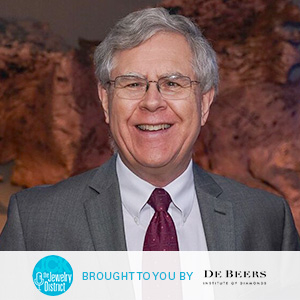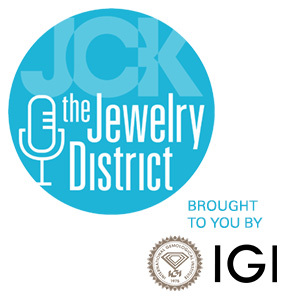
JCK editor-in-chief Victoria Gomelsky and news director Rob Bates sit down with Jeffrey Post, curator emeritus at the Smithsonian National Museum of Natural History, to hear where his love for mineralogy began.Jeffrey describes a visitor’s experience to the museum and shares some of the stories attached to the gems he has encountered over the course of his 32 years as its curator of gems and minerals (including a once-in-a-lifetime chance to study the famous Hope and Wittelsbach-Graff diamonds side by side).
Listen Now
Sponsored by De Beers: institute.debeers.com
Show Notes
00:10 Hosts catch up
03:50 Introduction to guest, Jeffrey Post
05:00 How Jeffrey’s interest in rocks and minerals began
08:45 The Smithsonian in the 1980s versus today
12:20 Jeffrey describes a museum visitor’s experience
15:10 Jeffrey’s favorite gems and minerals on exhibit
18:10 The legendary curse of the Hope Diamond
23:10 Studying the Wittelsbach-Graff and Hope diamonds side by side
28:45 Jeffrey’s successors and what’s next at the Smithsonian
Episode Credits
Hosts: Rob Bates and Victoria Gomelsky
Producer and engineer: Natalie Chomet
Plugs: @jckmagazine; institute.debeers.com, naturalhistory.si.edu
Show Recap
A passion for rocks and minerals
Jeffrey looks back and talks about what first got him interested in mineralogy. He grew up in a small town in Wisconsin, and as a kid, he would always come home with his pocket full of rocks he had picked up during the day. His fourth-grade teacher once brought in an amazing quartz crystal and passed it around during science class. As Jeffrey held it in his hands, the teacher explained that the crystal came out of the earth that way. That was a transformational moment for him.
He continued to study mineralogy throughout school, assuming he’d likely become a professor. He applied for a research mineralogist position at the Smithsonian, thinking it sounded intriguing. It wasn’t until later that he realized how amazing that opportunity was—to work at an institution with such an interesting collection and great legacy. Now he’s a part of that legacy.
Educating thousands, every day
In 1984, when Jeffrey first started working at the Smithsonian, it was a very popular place, which was part of his fascination with it. He recalls his first day, approaching the incredible building from the mall and thinking, “I work here!”
Before he accepted the position, Jeffrey had been torn. He had a few job offers at universities and liked the idea of teaching and mentoring. When he spoke to his contacts at the Smithsonian, they pointed out that about 10,000 people walk through their exhibits each day. What better place to teach? He was convinced.
The value of seeing the real thing
In today’s world, where you can easily Google a picture of the Hope Diamond, Rob wonders if the Smithsonian collection still holds the same appeal. Jeffrey notes that museums in general are busier than ever today. He points to an emotional need to see “the real things,” since we’re so accustomed to seeing images on our phones and devices. “One of the things our exhibit does is it puts the third dimension back into people’s life again,” Jeffrey explains.
Seeing wonders like the Hope Diamond in person gives a sense of awe and an emotional connection. Of course, one of the questions that visitors most frequently ask security is if this is the real Hope Diamond. “The answer is yes, of course. We only show the real thing,” Jeffrey says with a laugh.
A visit to the Smithsonian
Jeffrey walks the hosts through a visitor’s experience. The Smithsonian has 20 museums, a zoo, and much more. So it’s impossible to see it all in a weekend—let alone a day.
The Museum of Natural History is the largest and most-visited museum, right in the middle of the National Mall in Washington, D.C. You can enter from the south and be greeted by a large stuffed elephant (named Henry). For many, Henry is the first association they have with the museum. In fact, the phrase “I’ll meet you at the elephant” is built into the Washington lexicon.
You also can enter the museum on the north side, from Constitution Avenue, where one of the first things you’ll see is an impressive 8,000-pound slab of quartz crystals from Arkansas, which was positioned at the entrance in recent years. Jeffrey thinks the magnificent crystals—some of them nearly a foot long—give an immediate impression of the Smithsonian as a wonderland. It reminds him of one of his earliest experiences of wonder at crystals, and loves that he can share this magical feeling with visitors—a reminder that these minerals formed naturally in the earth.
But the main attraction is, of course, the Hope Diamond. It has become one of the must-see items in Washington, so crowds of people make their way up to the second floor to find it. In the 1990s, when Jeffrey helped create this exhibit, museum officials decided to put the Hope Diamond right in front. Their rationale was if the Hope were located in the back of the exhibit, it would draw people in but they wouldn’t pay attention to anything else on their way to see it. In its current configuration, people see the Hope Diamond first, then relax and take time explore the rest of the exhibit.
Some lesser-known favorites
When asked about his favorite display, Jeffrey has a hard time narrowing it down. He highlights a gemstone that was recently donated and put on display in April 2023: a green tsavorite garnet from Tanzania that is over 100 carats. It is a beautiful green stone, the likes of which most people haven’t seen before, he says.
Jeffrey also points to another fairly new addition to the collection: a bright red precious topaz, which can be found in the same gallery as the Hope Diamond. It’s called the Whitney Flame because the stone looks as if it’s on fire. Jeffrey thinks it has actually given the Hope Diamond a run for its money because of its striking appearance. It’s a fun reminder that there are many spectacular pieces in the collection besides the Hope Diamond.
The supposed Hope Diamond curse
Of course, Rob and Victoria had to find out if Jeffrey believes in the famous curse of the Hope Diamond. Jeffrey thinks there are a few reasons why the stone has this story—one is simply that people love stories.
He points out that the “curse” is a relatively recent addition to the Hope Diamond’s long history. The diamond came out of India in the 1600s, but the curse wasn’t mentioned until the early 1900s in a newspaper article in New York. At the time, the diamond was owned by a New York firm. There was a recession, and diamonds weren’t selling very well. Jeffrey theorizes that the story was a way to get people’s attention and perhaps drum up their interest in purchasing the diamond.
When Pierre Cartier was selling the stone to Evalyn Walsh McLean, he embellished the story a bit to pique her interest in it. And McLean seemed to enjoy spreading this legend as well. Despite her wealth, McLean had some unfortunate things happen in her life—the suggestible or superstitious could point to the curse of the diamond as the reason for all McLean’s misfortune.
Victoria quotes Jeffrey from an earlier conversation they had, which ties in with this idea: “It underscores one of the fascinating aspects of gemstones. They may be lost, but the nature of gems and particularly diamonds is that they can sit somewhere in a vault for long periods of time and pop out again. And they are as they were. There’s a sense of permanence. They’re out there forever. And that’s part of why we have a fascination with them—they tend to carry stories.”
When asked why people love gems, Jeffrey responds that beyond their obvious beauty, there is a sense of timelessness. “Gems are forever,” he says, “and when you put a gem in someone’s hands, almost inevitably the first thing they ask you is ‘Where did this come from? Who owned it? What’s the story?’”
Two legends side by side
Jeffrey has hands-on experience with yet another legendary blue diamond: the Wittelsbach. When Laurence Graff bought it, the Smithsonian approached him and asked to study it and put it on display it alongside the Hope Diamond. He agreed to lend it to the museum.
The research team set aside an evening after museum hours to study both diamonds. They did an all-night research program. They assembled all their instruments and team in their vault, as it had to be very secure.
Post describes carrying the Hope Diamond into the vault. He took a moment to look at the two diamonds next to each other. He was the first person to see them together. If you expose the Hope Diamond to ultraviolet light, it phosphoresces. He tried this to see if the Wittelsbach did too. It did. The team’s conclusion ultimately was that the two could not have originated from the same diamond. It was one of the great coincidences that these similar large blue diamonds both originated in India and ended up in Europe. And this was an experience Jeffrey could only have had at the Smithsonian.
“I anticipate the Smithsonian having a long, long future,” Jeffrey says. “And as long as it’s there, the gemstone will be there. I think that’s part of what makes gem so interesting, is that we’re always just part of the story. And the story has a history. And it has a future to it. And that’s sort of like working at the Smithsonian.”
- Subscribe to the JCK News Daily
- Subscribe to the JCK Special Report
- Follow JCK on Instagram: @jckmagazine
- Follow JCK on X: @jckmagazine
- Follow JCK on Facebook: @jckmagazine





